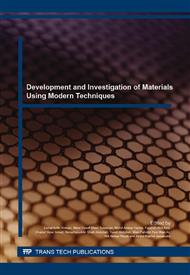[1]
N. Ktari, M. Jridi, R. Nasri, I. Lassoued, H. B. Ayed, A. Barkia, M. Nasri, Characteristics and functional properties of gelatin from zebra blenny (Salaria basilisca) skin, LWT. Food Sci. Technol. 58 (2014) 602-608.
DOI: 10.1016/j.lwt.2014.03.036
Google Scholar
[2]
M. Jridi, R. Nasri, I. Lassoued, N. Souissi, A. Mbarek, A. Barkia, M. Nasri, Screening of factors influencing the extraction of gelatin from the skin of cuttlefish using supersaturated design, Food Res. Int. 54 (2013): 1680–1687.
DOI: 10.1016/j.foodres.2013.09.026
Google Scholar
[3]
A.T. Alfaro, F. C. Biluca, C. Marquetti, I.B. Tonial, N.E. de Souza, African catfish (Clarias gariepinus) skin gelatin: Extraction optimization and physical–chemical properties, Food Res. Int. 65 (2014): 416–422.
DOI: 10.1016/j.foodres.2014.05.070
Google Scholar
[4]
M. Nikoo, S. Benjakul, M. Bashari, M. Alekhorshied, A. Idrissa Cissouma, N. Yang, X. Xu, Molecular characteristics and properties of gelatin 2 from skin of seabass with different sizes, Food Bio Sci. 5 (2014): 19–26.
DOI: 10.1016/j.fbio.2013.10.004
Google Scholar
[5]
I. Ratnasari, S. Y. Sudarminto, H. Nusyam, S. B. Widjanarko, Extraction Process Modification to Enhance Properties of Skin Gelatin of Pangas Catfish (Pangasius pangasius), Food Public Health. 4 (2014): 140–150.
Google Scholar
[6]
K. Shyni, G. S. Hema, G. Ninan, S. Mathew, C. G. Joshy, P. T. Lakshmanan, Isolation and characterization of gelatin from the skins of skipjack tuna (Katsuwonus pelamis), dog shark (Scoliodon sorrakowah), and rohu (Labeo rohita), Food Hydrocoll. 39 (2014).
DOI: 10.1016/j.foodhyd.2013.12.008
Google Scholar
[7]
S. Sinthusamran, S. Benjakul, H. Kishimura, Characteristics and gel properties of gelatin from skin of seabass (Lates calcarifer) as influenced by extraction conditions, Food Chem. 152 (2014): 276–284.
DOI: 10.1016/j.foodchem.2013.11.109
Google Scholar
[8]
A.T. Alfaro, G.G. Fonseca, E. Balbinot, C. Prentice, Physical and chemical properties of wami tilapia skin gelatine, Food Sci. Technol. Int. 33 (2013): 1–9.
DOI: 10.1590/s0101-20612013005000069
Google Scholar
[9]
B. Jamilah, K. G. Harvinder, Properties of gelatins from skins of fish—black tilapia (Oreochromis mossambicus) and red tilapia (Oreochromis nilotica), Food Chem. 77 (2002): 81–84.
DOI: 10.1016/s0308-8146(01)00328-4
Google Scholar
[10]
A.A. Karim, R. Bhat, Fish gelatin: Properties, challenges, and prospects as an alternative to mammalian gelatins, Food Hydrocoll. 23 (2009): 563-576.
DOI: 10.1016/j.foodhyd.2008.07.002
Google Scholar
[11]
F.A. de Wolf, Collagen and gelatin, Prog. Biotech. 23 (2003): 133-218.
Google Scholar
[12]
P. Montero, M. C. Gómez-Guillén, Extracting Conditions for Megrim (Lepidorhombus boscii) Skin Collagen Affect Functional Properties of the Resulting Gelatin, Food Chem. Toxicol. 65 (2000): 434–438.
DOI: 10.1111/j.1365-2621.2000.tb16022.x
Google Scholar
[13]
BSI (British Standards Institution), 1975. Methods for Sampling and Testing Gelatin (Physical and Chemical Methods). BSI, London, United Kingdom.
Google Scholar
[14]
C.S. Cheow, M.S. Norizah, Z.Y. Kyaw, N.K. Howell, Preparation and characterisation of gelatins from the skins of sin croaker (Johnius dussumieri) and shortfin scad (Decapterus macrosoma), Food Chem. 101 (2007): 386–391.
DOI: 10.1016/j.foodchem.2006.01.046
Google Scholar
[15]
P. Kittiphattanabawon, S. Benjakul, W. Visessanguan, T. Nagai, M. Tanaka, Characterisation of acid-soluble collagen from skin and bone of bigeye snapper (Priacanthus tayenus), Food Chem. 89 (2005): 363-372.
DOI: 10.1016/j.foodchem.2004.02.042
Google Scholar
[16]
M. C. Gómez-Guillén, B. Giménez, M. E. López-Caballero, M. P. Montero, Functional and bioactive properties of collagen and gelatin from alternative sources: A review, Food Hydrocoll. 25 (2011): 1813–1827.
DOI: 10.1016/j.foodhyd.2011.02.007
Google Scholar
[17]
B. Jamilah, K.W. Tan, M.R.U. Hartina, A. Azizah, Gelatins from three cultured freshwater fish skins obtained by liming process, Food Hydrocoll. 25 (2011): 1256–1260.
DOI: 10.1016/j.foodhyd.2010.11.023
Google Scholar
[18]
R.S.G. Silva, S.F. Bandeira, L.A.A. Pinto, Characteristics and Chemical Composition of Skin Gelatin from Cobia (Rachycentron Canadum), LWT - Food Sci. Technol. 57 (2014): 580–585.
DOI: 10.1016/j.lwt.2014.02.026
Google Scholar
[19]
F. Pati, B. Adhikari, S. Dhara, Isolation and characterization of fish scale collagen of higher thermal stability, Bioresour. Technol. 101 (2010): 3737–3742.
DOI: 10.1016/j.biortech.2009.12.133
Google Scholar


